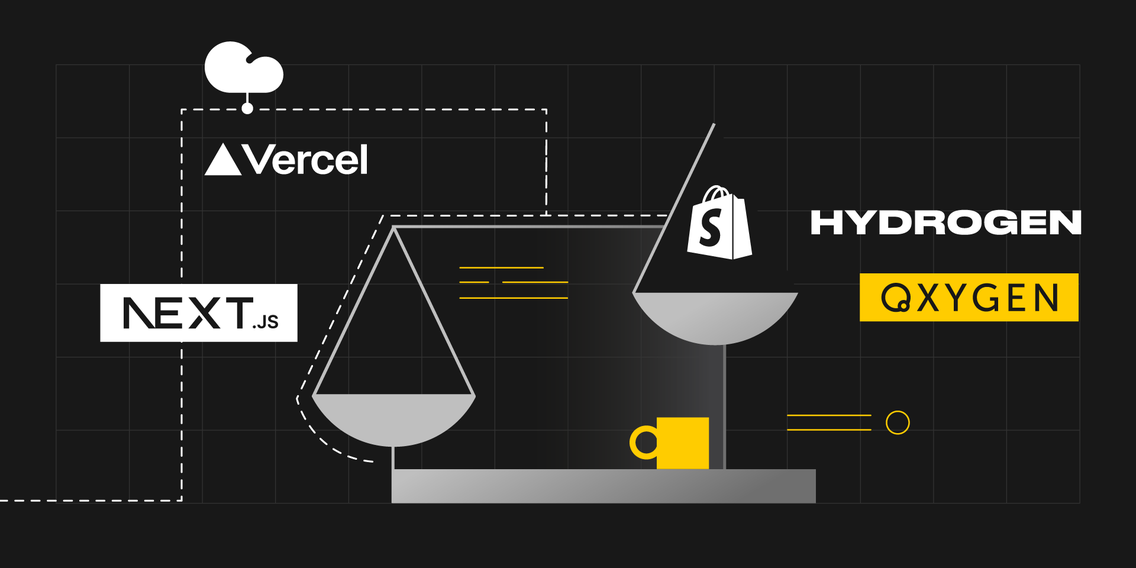7 min
October 15, 2025
Shopify Hydrogen: A Technical Analysis of the Future of Headless Commerce Architecture
The decision regarding frontend architecture is one of the most critical and long-term investments facing growing e-commerce companies. Within the Shopify Plus ecosystem, this dilemma centers on choosing between the outdated Liquid platform and an efficient headless approach.
In this context, Shopify Hydrogen—a native, opinionated framework—emerges as the sole, balanced solution. This material is an in-depth strategic analysis of this technology stack, designed to help you make an informed decision that will determine your brand's competitive advantage in 2025.
We will answer the key questions: What is RSC? What critical limitations does the Oxygen hosting platform bring? And most importantly—is Hydrogen a strategic advantage or a risky vendor lock-in that would be better replaced by the flexible Next.js?

Listen to the audio version of this article.
Architectural Context: From Liquid to Headless
Traditional Shopify is monolithic, meaning the presentation layer (frontend) and the business logic are tightly coupled. While this simplifies configuration initially, it generates serious long-term strategic problems:
1. Vendor Lock-in
Code created in Liquid is non-portable. Migrating away from Shopify requires a complete frontend rebuild, which is a significant financial and time burden.
2. Performance Issues:
Liquid, as a server-side templating language, is designed to generate static content. This complicates the creation of dynamic experiences like SPAs (Single-Page Applications) or PWAs (Progressive Web Apps). Furthermore, the installation of third-party apps "bloats" the system, increasing page load times.
Headless Commerce as a Strategic Imperative
The Headless Commerce approach is the answer to these limitations. It involves separating the frontend layer from the backend platform (Shopify) with communication via an application programming interface (API). This fundamental shift is driven by:
The demand for unique, brand-centric User Experiences (UX).
The requirement to deliver content in an omnichannel model (Web, mobile applications, kiosks).
The necessity of achieving the highest performance.
Before Hydrogen, teams had to build integrations with Shopify from scratch, using frameworks like Next.js or Nuxt.js, which incurred high development costs and complexity.
Hydrogen: Shopify’s Opinionated Answer
Shopify Hydrogen is positioned as the official, opinionated technology stack for headless commerce. It is a balanced solution that minimizes the complexity of a custom implementation while still offering the advantages of headless architecture.
The term "opinionated" means the framework makes key architectural choices for the developer (including the use of Remix and React Server Components), thereby accelerating development. This is a strategic compromise: Shopify sacrifices ultimate flexibility to offer a faster, more integrated path for its core user group, Shopify Plus subscribers. This is both a defensive move (retaining enterprise clients within the ecosystem) and an offensive one (increasing the value of its offering).
Technological Core: React Server Components (RSC)
Foundations: Remix and the Performance Engine
Hydrogen is a React framework. Although it was originally tightly coupled with Remix, it is currently framework-agnostic, with Remix remaining its key, opinionated base. Remix is a full-stack framework known for its focus on web standards and efficient nested routing.

RSC represents a paradigm shift:
Server components are rendered in advance on the server by default and have direct access to server resources and APIs (e.g., the GraphQL Storefront API).
Data fetching occurs closer to the data source, which, combined with streaming rendering via React Suspense, shortens the Time to First Byte (TTFB) and improves progressive content loading.
Value of the Component Library and Usability
Hydrogen's key advantage over generic frameworks is the @shopify/hydrogen-react library. This is a set of unstyled React components, hooks, and tools that instantly handle complex business logic (cart, analytics, Shop Pay).
The unstyled nature of the components is intentional: it gives full control over the design (ideal for design-focused brands seeking unique UX), but it means developers must build every visual element (i.e., the interface) from scratch.
Learning Curve: RSC technology is highly effective, but its implementation involves a steep learning curve. Developers must abandon client-side data fetching patterns and "think in terms of server components."
Deployment and Critical Oxygen Limitations
Oxygen is a globally distributed, serverless hosting platform, optimized for Hydrogen deployments, which Shopify offers as a native solution. It runs at the edge of the network based on Cloudflare workers technology, ensuring minimal latency and is included in the price for Shopify Plus subscribers. Oxygen simplifies the CI/CD process and eliminates the need for separate hosting (e.g., Vercel or Netlify).

Vendor Lock-in and Architectural Constraints
Despite its benefits, Oxygen has significant limitations that are a key risk factor:
The "Single Deployment Per Store" Limit: This is the most serious constraint. Oxygen supports only one Hydrogen deployment per Shopify online store. This prevents the building of complex multi-site configurations (e.g., B2B, wholesale, or regional sites running off a single product database), which is typical for the most advanced enterprises.
Restrictiveness: Oxygen is not a general-purpose platform. It lacks advanced hosting features (e.g., long log retention, monorepo support) offered by competitors.
The decision to use Hydrogen and Oxygen is a long-term commitment and acceptance of a strong lock-in effect. These limitations position Hydrogen in the segment of brands that have outgrown Liquid and need performance but are not among the most architecturally demanding corporate clients.
Comparative Assessment and Strategic Conclusions
Hydrogen vs. Next.js: Where is the Advantage?
| Feature | Shopify Hydrogen | Next.js |
|---|---|---|
| Shopify Integration | High (native hydrogen-react library). | Moderate (requires building all business logic from scratch). |
| Ecosystem / Flexibility | Optimized for Shopify, the project works independently of hosting (you can use Vercel/Netlify), but the native option (Oxygen) is restrictive. | Universal, mature, hosted anywhere. |
Realistic Risk and TCO Assessment
The decision to implement Hydrogen is irreversible over a period of several years and fundamentally changes the company's operating model:
Higher Total Cost of Ownership (TCO): It requires expensive, skilled React developers, as well as an additional investment to replace incompatible apps from the App Store.
Loss of Marketing Agility: The Shopify visual theme editor (Liquid) disappears. Changes to marketing content and page layout often become a developer task, unless an external Headless CMS with a visual editor feature is additionally implemented, allowing the marketing team to manage the frontend independently. However, this is a highly custom solution.
Hydrogen enables performance and a custom UX. Case studies of complex headless implementations often show a significant increase in conversion, which is confirmed by Shopify data. For example, the implementation for Nour Hammour (which saw a 63% increase) was a transition from another platform to Shopify Headless. This highlights that the custom design and optimization were key, not the technology itself. Therefore, ultimate success is not guaranteed—it is heavily dependent on the quality and expertise of the development team.
Choose Hydrogen if:
UX is your main differentiator, unattainable through a theme.
You are a large enterprise on Shopify Plus, fully committed to the Shopify ecosystem.
You have an in-house, qualified React team that needs optimized, native tools.
Stay with Liquid if:
Your priority is speed of deployment and low TCO.
Your business needs are met by the Shopify App Store ecosystem and the theme editor.
You do not have a dedicated React development team to maintain a custom application.
Shopify Hydrogen — In Short
The transition to Shopify Hydrogen is not just a technological change but a fundamental re-evaluation of the company's operating model, requiring the acceptance of a higher TCO.
Our analysis shows that despite powerful tools (RSC, Hydrogen-React), the biggest challenges lie in the strategic framework of limitations imposed by the Oxygen platform: the single deployment per store limit and the lack of support for monorepos. The final decision must always be a calculation of the long-term vendor lock-in risk versus the native optimization and speed of development offered by Shopify.
Hydrogen is the optimal choice for a very specific segment of the Shopify Plus market that needs a custom UX but does not require enterprise-grade architectural complexity. For them, it is an irreversible commitment to the Shopify ecosystem.
The final decision must always be a calculation of the long-term vendor lock-in risk versus the native optimization and speed of development offered by Shopify.
The choice of a Headless Commerce path must be preceded by a deep strategic audit that weighs the capabilities of your team, future growth plans, and acceptable TCO level. As specialists in Headless architectures and advanced Shopify Plus implementations, we will help you assess whether Hydrogen, Next.js, or perhaps a different platform is the optimal solution for you.
Contact us to find out which architecture will ensure your brand's agility and scalability for the coming years.




